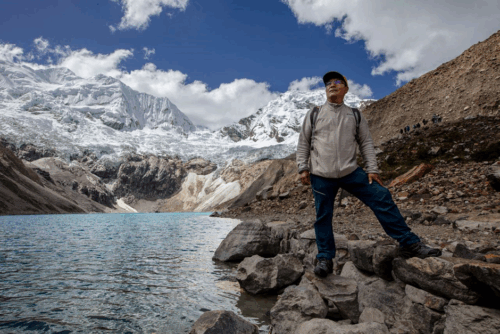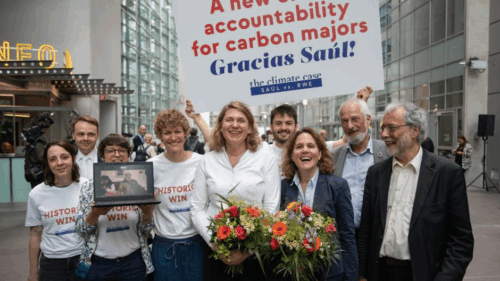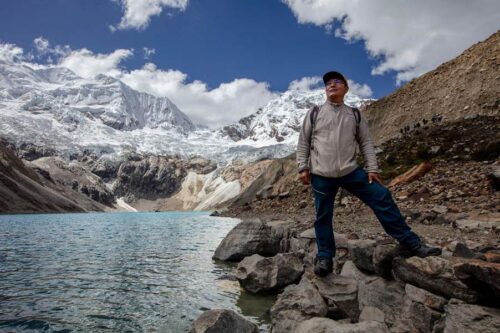by Lena Hedtke, Alexa Schurer, Giacomo Sebis
Large emitters can be held liable for the consequences of climate change. Will this ruling revolutionize climate protection?
The lawsuit brought by Peruvian farmer Saúl Luciano Lliuya against the large corporation RWE has been running for a good 10 years now. His home town, located in the Peruvian Andes, is threatened by melting glaciers. A lake above the town could overflow and flood the town. His demand: RWE should bear a share of the costs for the necessary protective measures in line with its emissions.

Saúl comes from the city of Huaraz in the northern part of Peru. Above the city lies Lake Palcacocha, a glacial lake at an altitude of 4500 meters. Behind the lake is a glacier, which is now in danger of large pieces breaking off and falling into the lake. These would flood the lake and cause meter-high floods in Huaraz. In 1941, a piece of glacier broke off once before, flooding the city and costing the lives of several thousand people. Since then, there have also been avalanches, for example in 2019 and 2024, whose subsequent meter-high waves could still be held back by the dam.
Lliuya filed a lawsuit against the energy company RWE in a German civil court on November 24, 2015. RWE is one of the largest single emitters of CO2 in Europe and alone is responsible for almost 0.5% of man-made emissions since the beginning of industrialization. Due to RWE’s complicity in climate change, Saúl’s aim was to transfer this complicity in the climate crisis to the threat posed to his homeland by the consequences of the climate crisis and to oblige RWE to bear the proportionate costs of around 0.5% for the protection of his city.
After Lliuya, with the help of Germanwatch and climate lawyer Roda Verheyen, brought an action against RWE before the Essen Regional Court on 24 November 2015, the action was dismissed by the Regional Court in 2016 on the grounds that RWE’s emissions were not directly responsible for the climate risks in Huaraz. Saúl lodged an appeal against this, which was deemed admissible by the Hamm Higher Regional Court (OLG) in 2017. This was the first time that an admissible lawsuit was filed in which corporate responsibility for climate risks was negotiated. On November 30, 2017, the Higher Regional Court decided to take evidence, whereupon an expert travelled to Peru for a site visit in May 2022 together with some judges from the Higher Regional Court of Hamm. In August 2023, the expert presented the resulting expert opinion. Finally, in March 2025, the oral hearings took place at the Higher Regional Court in Hamm, for which Saúl came to Germany. On 28.05.2025, the court announced the verdict. According to this, RWE does not have to participate in the protective measures for the house, as there is no threat of danger in the foreseeable future, but: In principle, large emitters of CO2 can be held liable if there is a concrete threat of impairment and the company’s disruptive capacity is fulfilled.
What specifically was decided and why is it so important?
RWE is therefore not directly liable in this case and does not have to pay Saúl any financial support for climate adaptation measures. At first glance, this appears to be a defeat and a failure for strategic court cases for the purpose of climate protection – which is exactly how the ruling was perceived to some extent in the German media landscape.
However, this belies two historic and absolutely unique aspects of this decision: firstly, the innovative legal reasoning on which the action was based, and secondly, the fact that liability of large emitters can now be assumed in principle and that it was only the specific, individual circumstances of Saúl’s case that prevented Saúl from claiming financial support – had things been slightly different, Saúl might even have been able to justify a financial claim.

Innovative interpretation of the law for climate justice
Initially, the legal justification for the proceedings was very innovative. Saúl based his action on Section 1004 (1) of the German Civil Code (BGB). This provision normally applies when someone’s property is interfered with and the interferer is required to remove the interference. This means that if someone interferes with the property of another person, the latter can invoke this paragraph in court to demand that the interferer cease the interference.
A typical use case for this provision is disputes between neighbors, for example when plants or trees grow into a neighboring property or fruit lands on neighboring property. In such cases, the owner of the affected property can demand the removal of the plants or trees growing into the property or the fallen fruit.
This basic idea was taken up in Saúl’s proceedings. Due to the cross-border nature of the climate crisis, there is a kind of global neighborly relationship between a major emitter such as RWE and Saúl – the effects of RWE’s CO2 emissions should therefore have a similar effect on Saúl’s property as the tree growth of a direct neighbor. And it was precisely to this case that Section 1004 (1) of the German Civil Code was applied in order to justify why RWE should refrain from CO2 emissions and, in case of doubt, pay for adapting to the effects of the climate crisis.
The court has allowed this reinterpretation of Section 1004 (1) of the German Civil Code in principle, thus enabling previously unrecognized potentials of this basically rather colorless provision.
Financial claims against major issuers legally possible
The fact that Section 1004 (1) BGB was recognized by the court as the basis for claims in this case also has far-reaching consequences: It means that large emitters such as RWE can in principle be held liable for the costs of climate adaptation.
This is the first judgment, both in Germany and worldwide, in which financial responsibility for large CO2 emitters has been established in principle. In previous proceedings against large emitters, financial responsibility was either rejected or – as in the much-cited case of Milieudefensie v. Shell from the Netherlands – was not even the subject of the legal dispute. However, there is now a first precedent that has dealt in detail with the legal issues surrounding the financial responsibility of CO2 emitters.
However, this general statement could not pass its first litmus test in the proceedings here – not because there were legal doubts, but because the facts surrounding Saúl’s property simply did not allow the legally necessary hurdles to be overcome. In order for a claim under Section 1004 (1) of the German Civil Code (BGB) to be established, certain requirements of this provision must be met. In particular, the emissions must be the cause of the climate-related risks to Saúl’s property, RWE’s contribution must be significant enough to be legally relevant and the probability of damage to the property must be high enough for RWE to be held liable. The court answered the first two aspects in Saúl’s favor: RWE’s CO2 emissions were a contributory cause of the climate-related hazards at the property, and because RWE’s emissions amounted to 0.47% of global CO2 emissions, it was also sufficiently significant. Only the probability of damage to the property was too low: court-appointed experts had determined that the probability that Saúl’s property could be affected by flooding in the next 30 years was only 1% – too low in the eyes of the court to lead to legal liability.
What significance does the ruling have for future climate lawsuits and global climate justice?
The ruling recognizes for the first time that companies can be held liable under civil law for their share of responsibility for the global climate crisis. In this respect, major emitters such as RWE have a duty, at least in principle, to reduce their climate footprint in order to avoid liability risks.
Significant contributions to climate change can constitute an unlawful interference with property rights, according to the court. This type of reasoning can now be cited and applied in courtrooms around the world, and could make future climate litigation much easier.
In addition, the judgment established a certain international jurisdiction of European courts, which means that European courts can in principle rule on climate claims brought by non-European residents. However, those affected may choose whether they want to apply the law of the country in which the climate-damaging actions were carried out or where the damage could occur. In his case, Saùl opted to sue in Germany, i.e. the place where climate damage was carried out by RWE. According to the court, the place of residence also plays no role in a lawsuit as long as property is affected. Plaintiffs can therefore also be permanently located somewhere other than where the damage to the property occurs, or somewhere other than where, for example, the plaintiff’s affected property is located.
In the Saùl case, according to Jan-Erik Schirmer, an expert in climate liability, a tiny detail was the downfall of the lawsuit: “If it hadn’t been Lliuya who had sued, but a neighbor with a property closer to the river, the experts would probably have assessed the risk of flooding to be significantly higher and the Higher Regional Court of Hamm would have recognized an imminent impairment.”
Could the ruling cause a wave of lawsuits that could overwhelm the courts?
The Hamm Higher Regional Court does not share this fear, which was raised by RWE during the proceedings. Nevertheless, it is possible that the ruling will be used as a door opener for further climate lawsuits. Concerns about climate lawsuits could mean that major emitters will have to factor the risk of legal liability into their business models to a greater extent in future. This could increase the incentive to reduce emissions, not only for RWE, and an “improvement” in climate protection efforts could occur voluntarily. Once a company is involved in a process, it is not only the financial risk that plays a role, but also the reputational risk. Investors are paying more attention to climate liability factors and are not investing where there is a risk of mass litigation.
Despite all this, many lawsuits continue to fail due to procedural hurdles, the reluctance of the courts or problems with evidence. It also seems difficult to predict how courts in other jurisdictions would treat similar situations, taking into account local laws, although countries such as the UK, USA, Netherlands or Japan have similar legal requirements to those in Germany. Since the claim to termination of a property interference is not a “legal high-water mark”, but a very basic claim that exists in many legal systems, in some cases with similar claims, it is at least conceivable that the argumentation patterns from Saúl v. RWE will be received and incorporated into the reasoning of other courts.
Literature
- https://rwe.climatecase.org/de/rechtliches#:~:text=Bahnbrechendes%20Urteil,vor%20der%20Klimakrise%20zu%20schützen
- https://rwe.climatecase.org/de/pressemitteilungen/artikel/bahnbrechendes-urteil-klimaklage-gegen-rwe-grosse-emittenten-koennen
- https://rwe.climatecase.org/de/rechtliches#:~:text=Bahnbrechendes%20Urteil,vor%20der%20Klimakrise%20zu%20schützen
- https://rwe.climatecase.org/de
- https://www.dentons.com/en/insights/articles/2025/may/29/luciano-lliuya-v-rwe-ag-german-court#:~:text=However%2C%20there%20are%20significant%20unresolved,by%20courts%20around%20the%20world
- https://www.lto.de/recht/nachrichten/n/olg-hamm-5u1517-klimaklage-peruanischer-bauer-gegen-rwe-abgewiesen
- https://www.clientearth.org/latest/press-office/press-releases/mega-emitters-can-be-liable-for-climate-change-contribution-german-court-confirms/#:~:text=Under%20the%20‘polluter%20pays’%20principle%2C,the%20mitigation%20of%20flood%20risks
- https://www.tagesschau.de/wirtschaft/energie/rwe-klima-klage-peru-landwirt-100.html
- https://www.dw.com/en/german-court-rejects-climate-case-against-energy-giant-rwe/a-72693362#:~:text=Speaking%20after%20the%20verdict%2C%20Lliuya%27s%C2%A0lawyer,lawsuits%20against%20fossil%20fuel%20companies
- https://amnesty-klimakrise.de/2025/03/einzigartige-klimaklage-vor-dem-oberlandesgericht-in-hamm-saul-luciano-lliuya-verlangt-unternehmerische-haftung-des-kohlekonzerns-rwe-fuer-klimarisiken/
- https://www.germanwatch.org/de/bahnbrechendes-urteil-der-klimaklage-gegen-rwe
- https://www.deutschlandfunkkultur.de/saul-luciano-lliuya-peru-bauer-rwe-klimaklage-100.html
- https://climatecasechart.com/non-us-case/lliuya-v-rwe-ag/
- https://www.bundestag.de/resource/blob/1095494/Klimaklage-gegen-rwe.pdf

